Note: This novel by Alice McDermott has been named a FINALIST for the Kirkus Prize for 2017. She was WINNER of the National Book award in 1999 for Charming Billy.
“The madness with which suffering was dispersed in the world defied logic. There was nothing else like it for unevenness. Bad luck, bad health, bad timing. Innocent children were afflicted as often as bad men. Young mothers were struck down even as old ones fretfully lingered. Good lives ended in confusion or despair or howling devastation. The fortunate went blissfully about their business until that moment when fortune vanished – a knock on the door, a cough, a knife flash, a brief bit of inattention…There was no accounting for how general it was, how arbitrary.” – Sister Jeanne
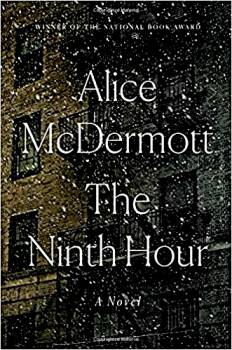
Life is busy and all too short, and when choosing books, it is often tempting to choose books in which the action provides new insights into life as we already know it. Alice McDermott, well-known as a “Catholic” author, presents characters whose lives and decisions here are far different from my own, yet I found her novel stunning – enlightening, humane, and thoughtful. Considering her themes from the highest levels of universality, not specific to Catholic doctrine, McDermott raises questions about life and death; innocence and guilt; the rewards, if any, which come from leading a “good” life; the penances one self-imposes for actions which feel like crimes; the voluntary performance of good works, even at a time filled with personal obligations; and the decisions one sometimes makes with the most honorable of intentions, even when they violate the boundaries most of us consider sacred. Most remarkably, McDermott does all this within a relatively simple plot, peopled with characters we come to like and even admire at a time in our history which is quite different from the present day.
Following three generations of a single family, the novel begins with a thirty-two-year-old man named Jim, a handsome, married man who has “refused to give up life for the duties of a job.” Now living in a “railroad flat” along tracks which have no “right” side, Jim has just lost the job he had with the railroad because of his “unreliability.” Sending his wife out to buy food, he seals up the flat, turns on the gas, and kills himself in a fiery explosion. Annie, his pregnant wife, returns home to find her husband dead and the apartment ablaze. Devastated, alone, and pregnant, she is helped by nuns who arrive after the fire and the death, but even with their help, she must learn to accept the fact that Jim cannot be buried in sacred ground because suicide is a cardinal sin against God and the church.
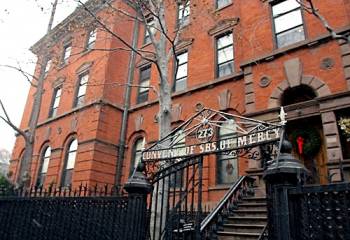
The Convent of the Sisters of Mercy is just one of over two dozen convents active in Brooklyn in the 1950s.
The nuns who are so helpful to Annie belong to the Little Nursing Sisters of the Sick Poor, one of over two dozen religious communities active in Brooklyn in the middle of the twentieth century. Annie is given a job in the laundry of this convent, and, after her daughter Sally is born, she is able to bring her to the basement with her each day. Her job allows her to stay alive physically, emotionally, and spiritually, while also providing some of the nuns with the chance to satisfy their own maternal yearnings. Gradually, the characters surrounding Annie and Sally, including the nuns, develop real personalities, as the sisters do not blindly accept the dictates of the church, often molding church teachings to fit the odd circumstances in which the people dependent upon them sometimes find themselves. They feel free to interpret what they believe the Bible and the church regard as right.
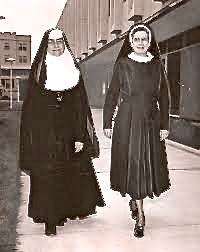
In the early 1960s many convents modified their dress. In 1963, the Sisters of Mercy made this change, and soon afterward changed again to regular street dress.
The novel moves back and forth in time and through generations. Years later, when Sally has grown up and finished school, she thinks of joining a convent and spends some time working with the Little Nursing Sisters of the Poor helping to care for a sick woman in Brooklyn. Soon Sally finds herself dealing with questions about church doctrine, how to interpret it, and how to deal with the guilt which arises from a decision made in earnest and with love, though perhaps contrary to strict definitions of “right.” Eventually, the novel flashes back two generations to a new speaker and the subject of Great Aunt Rose, who spent her life taking care of Red Whelan, the man who substituted for the speaker’s great grandfather in the Civil War, a time in which people with enough money could hire someone to take their place on the battle lines. In the case of Red Whelan, who lost both a leg and an arm, the visual reminders of his sacrifices constantly draw attention to the injustices at the time and the fact that hiring a substitute soldier from among the poor was not considered a sin then.
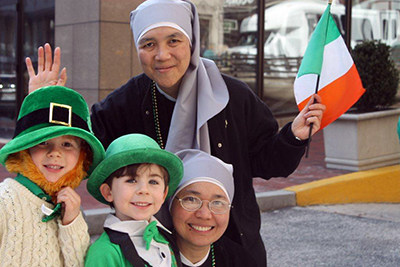
The Little Nursing Sisters of the Sick Poor have kept their traditional dress. Here two sisters enjoy the St. Patrick’s Day Parade in 2013.
Throughout the novel, as the past and present are revealed, the action keeps the reader totally engaged, but it also keeps the reader thinking, pondering decisions and outcomes and the position of the church in evaluating right and wrong. Significantly, the main characters are all women, many of them religious, committed to doing what is “right” in the highest sense, regardless of whether their decisions meet all the usual church requirements for right and wrong. At one point, the “greatest good” for one character leads to an action which some might regard as murder – a decision reached by two people, each working independently. Importantly, it is the nuns and the women who act in the absence of uninvolved priests who make these decisions. Though one might question why the priests seem to remain oblivious to daily life in their parishes, it is easy to justify some of these decisions, including the possible murder, in terms that women would understand in a totally different way from men. Perhaps, the novel suggests, right and wrong do not have absolute interpretations.
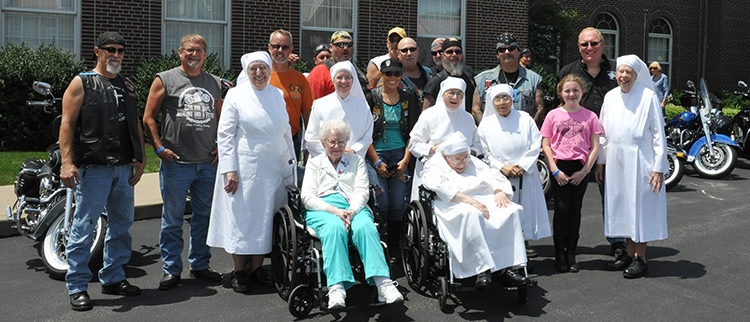
Here the Teamsters participate in their annual motorcycle ride to benefit the Little Sisters of the Sick Poor, Summer, 2015. About eighty bikers participated.
Describing this unique novel raises unique challenges. It is obviously literary, with not a word out of place. The descriptions, both physical and emotional, are realistic and often moving, setting the scene and creating an atmosphere which engrosses the reader and leads to deeper understandings. The novel has its share of heart-rending sorrow, and while it cannot be considered “gothic” in the broad sense of the word, or “sentimental” in the Dickensian sense, it does operate on the edge of a grand stage with grand sentiments. Small actions often lead to big results with big consequences, as in an opera, and the tension is sometimes almost palpable. Epic in its themes, the book is intimate and personal in its effects on both the characters and the reader. Love guides the action for three generations, becoming even more poignant as one considers the fact that the convents and the religious who so contribute to this action are missing and almost non-existent in our present generation. As one sister says, “I gave up my place in heaven a long time ago, out of love for my friends.” How sad that she found it necessary to do this, and how sad, too, that there are fewer like her to follow now and as time goes on.
Photos: The author’s photo appears on http://irishamerica.com
In the 1950s, Brooklyn had over two dozen convents, including this large building occupied by the Sisters of Mercy. Most of them, including this one have now closed: http://www.brooklynpaper.com/
In the 1960s many convents changed the dress for their nuns. Here in 1963 is the adaptation to a shorter dress by the Sisters of Mercy. Soon after this, the dress changed again to regular street clothes. http://archives.commons.udmercy.edu
St. Patrick’s Day Parade in 2013 shows two of the Little Sisters of the Sick Poor enjoying the fun. This order has not changed it habit to street dress. http://www.littlesistersofthepoorbaltimore.org
In summer, 2015, the Teamsters participated in their annual motorcycle ride to benefit the Little Sisters of the Sick Poor. About eighty bikers took part. http://www.littlesistersofthepoorpittsburgh.org/

